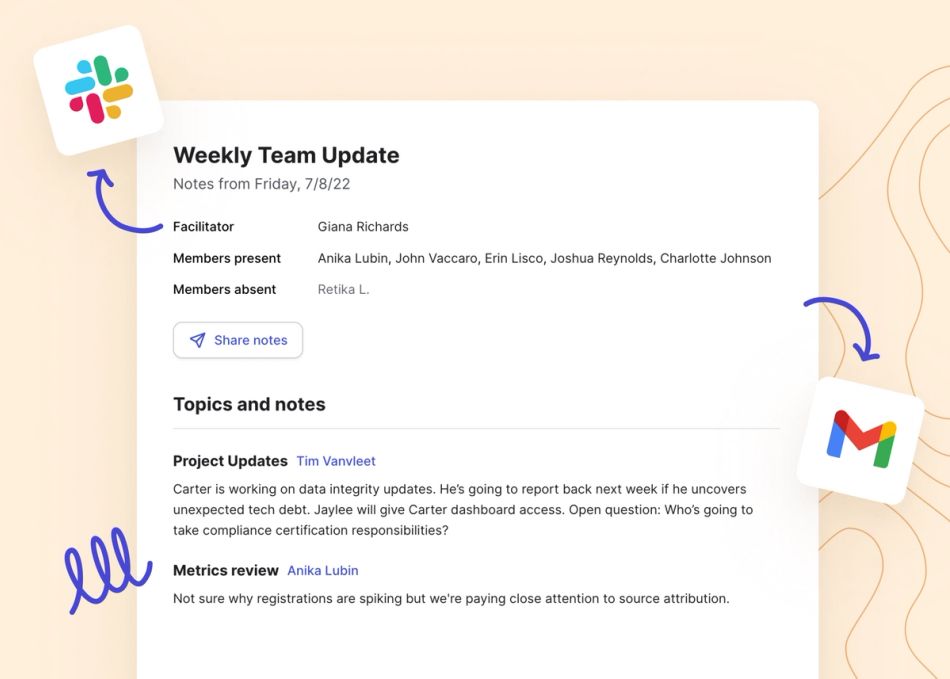
Table of contents
- Don’t try and cover too much
- Align at the beginning of the day
- Don’t stray from the daily huddle agenda
- Don’t create separate huddles for each internal project
- Start and end your huddle on time
- Keep the tempo upbeat and engaging
- Use Range as a meeting management tool to stay on track
- Run your daily huddles on a regular basis
Football team or not, there’s power in the act of huddling.
Heads come together to align focus, discuss tactics, maybe even recalibrate. A few moments where, together a team, you align on your next play and break with a sense of clear next steps.
So whether your team’s tackling opponents…or a product backlog, running tactical plays… or tactical meetings…
A regular team huddle can help you unlock greater teamwork and efficiency. In this article, we’ll give you the play-by-play of how to run a daily huddle that sets your team up for victory.
8 Tips for Amazing Daily Huddles
1. Don’t try and cover too much
When you try to cover too much, you’ll go over time. A daily huddle is about building your rhythm and creating shared focus on your team — not discussing even tiny detail. Keep things focused and moving at a good pace. For instance, in your problem-solving section, make sure to triage issues quickly or take it offline after the meeting.
2. Align at the beginning of the day
Daily huddles work best when they happen at the beginning of the day. Especially with remote work, finding a time that works for teams spread across time zones can be challenging—which is why many teams opt to use an async daily huddle or check-in.
3. Don’t stray from the daily huddle agenda
You’ve only got 15 minutes, so it’s crucial to use an agenda (see below!) and stick to it!. Also, since it’s all about building a rhythm, it’s important to follow the same format every time so that folks know what to expect and the huddle becomes an easy-flowing, second nature practice.
4. Don’t create separate huddles for each internal project
We’ve all been on teams where you’re spread across multiple projects and end up attending back-to-back meetings all morning because of it. Avoid this with your daily huddles.
Try to cover most of your team’s projects in one. If it gets too large or cumbersome, consider moving to an asynchronous format rather than having many separate huddles.
5. Start and end your huddle on time
Most teams do huddles first thing in the morning. Start right on time even if you have stragglers. Use a timer and end the meeting on time, whether you got through everything or not. This will slowly train attendees to keep things moving more quickly.
6. Keep the tempo upbeat and engaging
The best daily huddles move quickly and have a high degree of engagement and collaboration. Try kicking the meeting off with a fast team-building question to get the dialog going and make sure to build in space to celebrate successes (even early wins are big).
7. Use Range as a meeting management tool to stay on track
Since it’s such a brief meeting, every second matters. This is why it’s key to have a facilitator who’s experienced at keeping things on track.

Many teams find it helpful to use Range as a meeting management tool, since it helps you move through the agenda in real-time and times out each topic for you. We also put together a facilitation cheatsheet your team can follow to keep your daily huddle on track.
8. Run your daily huddles on a regular basis
Again, rhythm is key. With the huddles, it’s important to get into the daily cadence so you can spot issues early on and triage blockers as they come up.
Daily goal tracking as part of the huddle keeps teams marching toward a common goal and helps individuals feel purpose and progress in their day-to-day work. It also builds greater team accountability.
Your daily huddle agenda
Here’s an example agenda you can use to execute an effective daily huddle on your own team, including some tips to get the most out of your time.
Check-in (2 minutes)
How’s everyone doing? (Red/yellow/green)
Tip: Swap this out with a fast team-building question every other day to boost engagement.
Focus areas (3 minutes)
What are you focused on for the next 24 hours?
Tip: Only share key activities, meetings, and decisions — not every granular detail of how you’ll be spending the next day.
Metrics + wins (5 minutes)
How are we tracking toward product metrics? What wins can we celebrate?
Tip: Prepare these ahead of time so you don’t have to spend time during the meeting pulling up your metrics tracker or having people think of what to share.
Problem-solving (5 minutes)
Where are you stuck? What issues should we all be aware of?
Tip: Encourage honest sharing by taking time to share your own blockers upfront. As a general rule, if someone goes a few days without sharing any type of blocker, there are probably bigger issues you’re not seeing.
Is a daily huddle different from a daily standup?
The daily huddle and daily standup are two names for the same type of meeting. Some teams also refer to it as the daily scrum meeting.
All are designed to be fast and focused, and typically revolve around team members sharing a brief status update and asking for help on blockers.
One area where daily huddles differ slightly is that oftentimes teams also use them for a quick check-in around product metrics.
Bring your team to victory with huddles in Range
Whether you choose to run them live or asynchronously, Range has tools built in that help you maximize daily huddle time.
Async daily huddles in Range
If you’re not looking to add another meeting to the mix, Range Check-ins are a great way to get all the benefits of the daily huddle asynchronously instead.
With async daily huddle software, you can
- Build alignment around in-flight work, wins, and goals while also reducing meeting load
- See how everyone’s doing (red/yellow/green + emoji) — team-building questions are built-in too
- Easily share a huddle update each morning in 5 minutes or less
- Customize prompts (https://www.range.co/blog/check-in-prompts) to fit your team’s huddle format
- Connect tasks and context from your team’s other tools to create more meaningful updates
- Flag blockers or tag teammates to get the help you need
- Share and read each other’s daily huddles directly from Slack or Microsoft Teams
“[Before we started using Check-ins], it was impossible for teammates to see what they could pitch in and help with. What I’m seeing now is totally different and part of our culture. People are seeing items in Check-ins, seeing they’re working on similar things, and inviting each other to collaborate.” — Kristin Toole, Senior Manager at Adobe
Daily huddle meetings with Range
If your team’s more a live meeting type of crew, Range has daily huddle software for that too.
- Seamlessly built your agenda and pull in relevant huddle topics—like metrics, wins, and blockers
- Kick things off with an opening round or check-in, Range has over 300 team-building questions built-in
- Facilitate like a pro, with a spinner to decide who speaks next and topic timers to keep everyone on track
Daily Huddle FAQs
What’s a daily huddle?
The daily huddle meeting is a brief, 15-minute meeting where team members come together to share progress, work through quick tactical issues, and set next steps.
It's a daily meeting and normally follows a standard format each time, for consistency and rhythm.
Huddles (sometimes called standups) are used across a variety of industries, not just tech, to improve collaboration and keep information flowing across the team.
How did daily huddles start? 
The practice of huddling up as a team originally came from Paul Hubbard, a deaf quarterback who played football at Gallaudet University in the 1890s.
His team used sign language to communicate plays but found it too easy for opponents to see the signs and pick up on what was coming. Hubbard came up with the idea of circling up so the team could still communicate without giving away plays.
Taking lessons learned from the football huddle, the practice was adopted by medical professionals in the 1980s as a way to more effectively hand-off patient updates at the end or beginning of a shift. Later, huddles were adopted by the agile development community as a way to bring focus and alignment in working toward shared product goals.
Does a daily huddle need to be an in-person meeting?
Short answer: No. While a daily huddle can be a synchronous touchpoint, many teams choose to run them asynchronously instead.
Especially if your remote team is co-located across a couple of different time zones, asynchronous can offer more flexibility on the timing aspect while still keeping everyone aligned.
Async is also beneficial for teams with a high meeting load already who are trying to reduce some of their meeting dependency.








